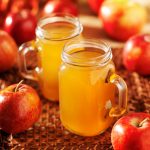The business, Monnow Creatives Ltd is starting to manufacture cider products. Whilst rooting through the web for articles related to cider production, I came across Andrew Lea’s web-site http://www.cider.org.uk/aroma.html, which looked at the aroma molecules that characterise cider. It’s worth a look purely for honing up one’s knowledge in this area. Apple variety and their blends, fermentation, types of yeast (natural or otherwise), the seasons etc. all have their part to play in the quality of the cider produced.
Subsequent research shows cider aroma to be mainly alcohols, esters, fatty acids, aldehydes and ketones with at least 200 now recorded. Gas chromatography–olfactometry (GC-O) analysis reveals that 2-phenylethanol and its esters, β-damascenone, ethyl 3- & 2-methylbutanoate, diacetyl, isoamyl alcohol, 2- & 3-methylbutanol, 2- & 3-methylbutanoic acid, guaiacol, and methyl anthranilate might be especially critical to apple cider aroma (Mangas et al., 1996; Genovese et al., 2002). Xu et al., (2007) comprehensively covers the great range of compounds. There are indeed a plethora of papers covering aroma when checking various papers.
Fermentation can influence the production of higher alcohols and fusel oils which are not that desirable as flavour components. Too high, and they increase in proportion so 12°C is ideal as a temperature for fermentation because this is an optimum for yeasts living in apple juice. The 70’s generally provided much of the base information on aroma. Analysis of draught dry cider revealed 43 definite components and a further half that number being possibles (Williams and Tucknott, 1971). Fruity notes were identified with low boiling esters and ethyl 2-methylbutrate. They also identified 4-ethylguauicol and 4-ethylphenol which appear to be associated with taints and give a ‘cresol’ character.
As well as English cider varieties, the Asturia type ciders have been assessed too from an aroma point of view (Calixto & Bernejo, 1980; Mangas et al., 1996; Blanco-Gomis et al., 2001; Madrera et al., 2005). They present an overall picture on the aroma and whilst there are differences the componentry is the same but in different proportions.
The minor neutral components or which there are many have been identified in a 1,2- propanediol-washed trichlorofluoromethane extract of a cider distillate based on the sweet coppin variety of cider apple, using gas chromatography and gas chromatography-mass spectrometry (GC-MS) (Williams and Tucknott, 1978). Olfactometry (sniffing) on the individual components highlighted esters as the main characteristic compounds.
Much of the UK’s knowledge and expertise resided with Long Ashton Research Station and was often visited by those seeking scientific advice on cider apples, production and sensory characterisation. Dr Lea’s research pinpointed a molecule 2-methyl 4-pentyl 1,3-dioxane which lent a ‘green’ note unique to cider. There are other compounds called dioxalanes in cider that act generally as aroma chemicals and perhaps act as precursors for other flavour active molecules. Given that cider aroma will be one of the key sensory appeal factors I’m hopeful that my colleague Dr. Sachin Chandra will also help to characterise our cider.
I shall add to the list of references as this is really meant to be an encyclopedic entry. Any views on cider flavour will be welcome.
References
Calixto, F. S., Bermejo, J. (1980) Volatile components of cider and table apples. An. Bromatol. 32, pp. 281-288.
Blanco-Gomis, D., Alonso, J. J. M., Cabrales, I. M., Abrodo, P. A. (2001) Gas chromatographic analysis of total fatty acids in cider. J. Agric. Food Chem., 49, pp. 1260-1263.
Genovese, A., Ugliano, M., Pessina, R., Lamacchia, C., Moio, L. (2002) In Aroma-Active Compounds in Annurca Apple Cider Distillate; Flavour Research at the Dawn of the Twenty-First Century, Proc. of the Weurman Flavour Research Symposium, 10th, Beaune, France, June 25-28, 2002; LeQuéré, J. L., Etievant, P. X., Eds.; Intercept Scientific Technical Publishers: London, pp 618-621.
Mangas, J. J., González, M. P., Rodriguez, R., Blanco, D. (1996) Solid phase extraction and determination of trace aroma and flavour components in cider by GC-MS. Chromatographia 42, pp. 101-105.
Madrera, R. R., García, N. P., Hevia, A. G., Valles, B. S. (2005) Application of purge and trap extraction and gas chromatography for determination of minor esters in cider. J. Chromatogr. A 1069, pp. 245-251.
Pollard, A., Kieser, M. E. and Beech, F. W. (1966), Factors influencing the Flavour of Cider: the Effect of Fermentation Treatments on Fusel Oil Production. J. Appl. Bacteriology, 29 pp. 253–259. doi: 10.1111/j.1365-2672.1966.tb03475.x
Xu, Y., Fan, W. and Qian, M. C. (2007) Characterization of aroma compounds in apple cider using solvent-assisted flavor evaporation and headspace solid-phase microextraction. J. Agric. Food Chem., 55, pp. 3051−3057.
Williams, A. A. and Tucknott, O. G. (1971), Volatile constituents of fermented cider I.—Draught dry cider blend. J. Sci. Food Agric., 22 pp. 264–269. doi: 10.1002/jsfa.2740220513
Williams, A. A., Tucknott, O. G. (1978), The volatile aroma components of fermented ciders: Minor neutral components from the fermentation of sweet coppin apple juice. J. Sci. Food Agric., 29 pp. 381–397. doi: 10.1002/jsfa.2740290414


Leave a Reply